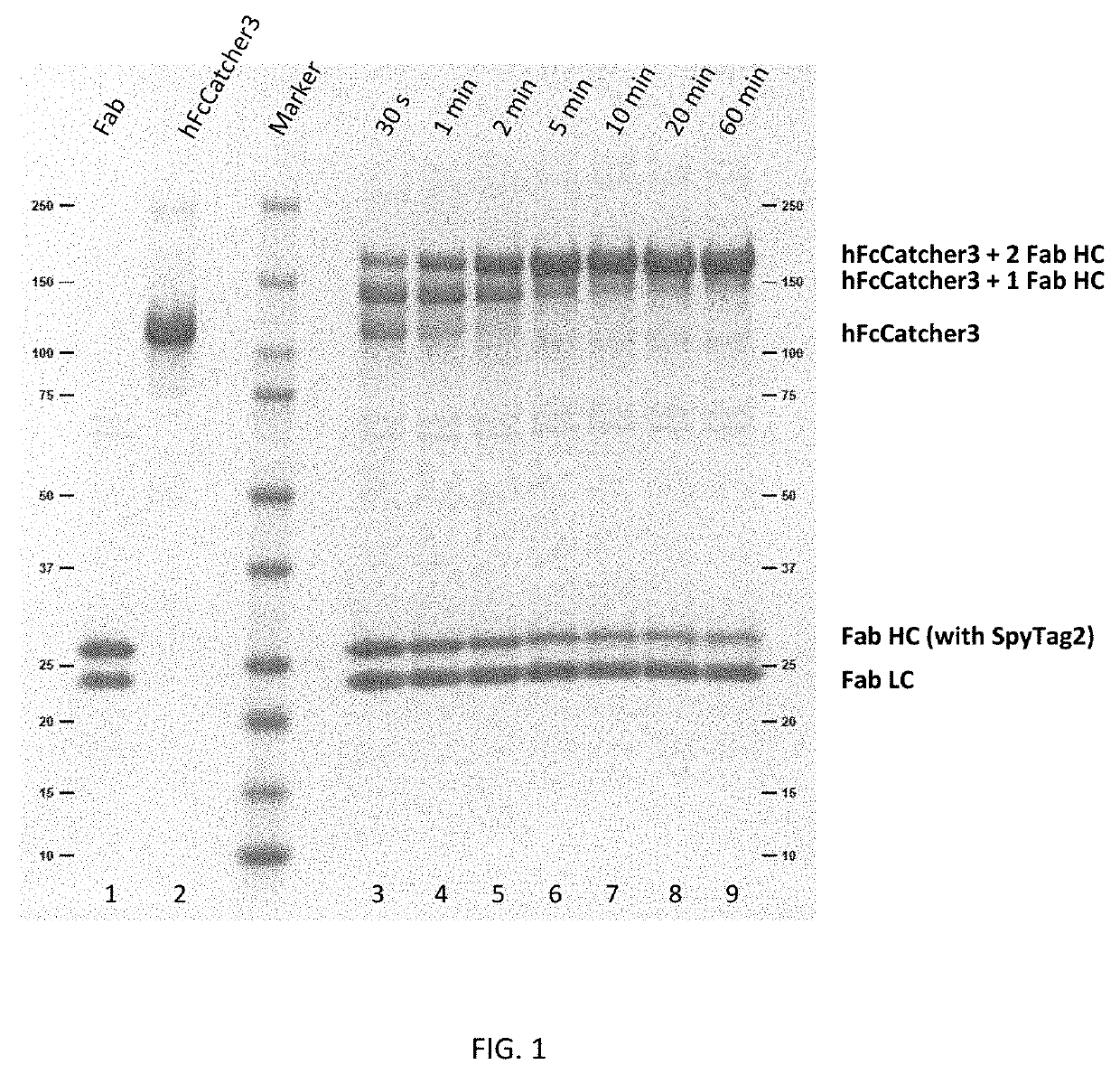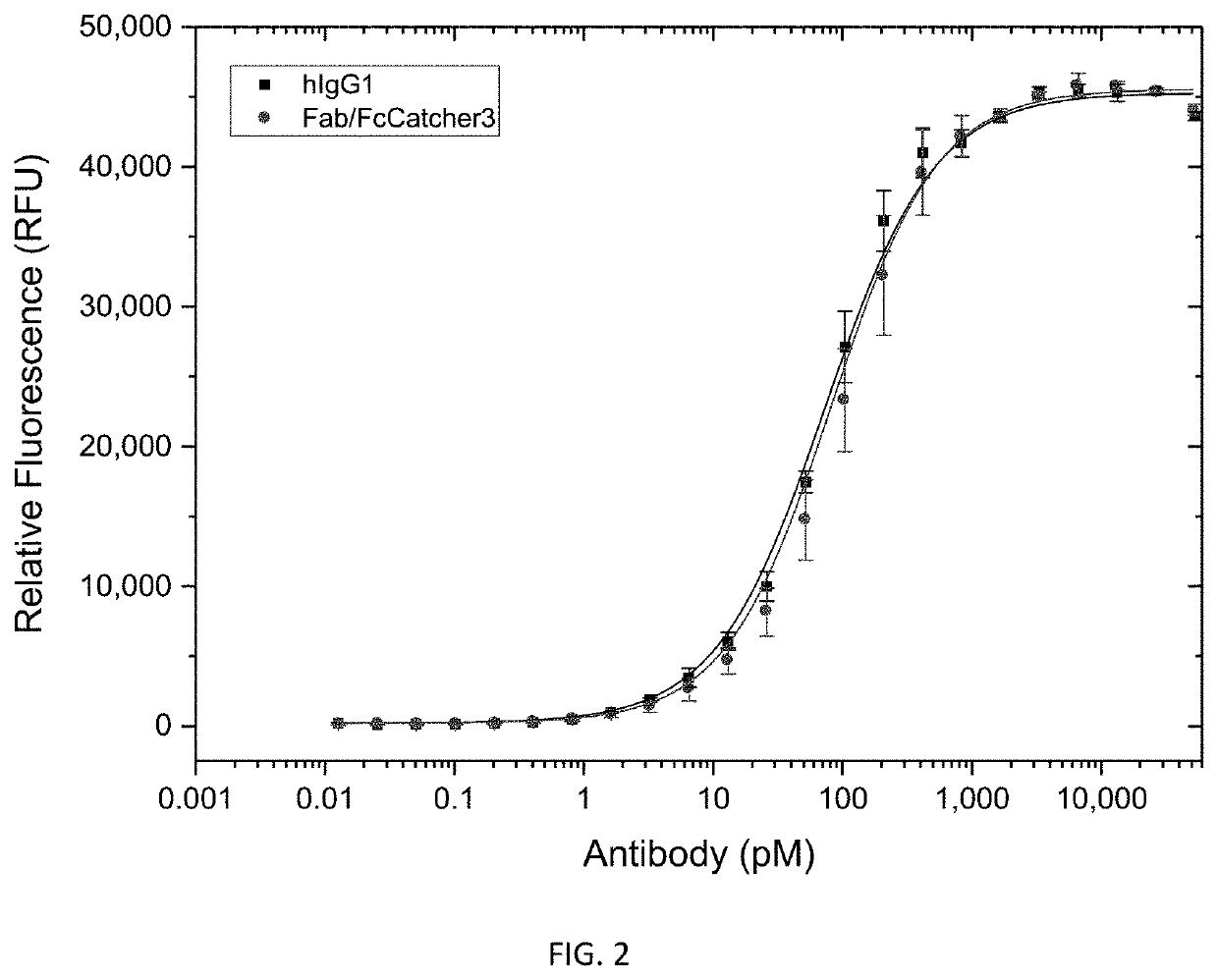Antigen binding fragments conjugated to a plurality of fc isotypes and subclasses
a technology of fc isotypes and antigen binding fragments, which is applied in the field of antigen binding fragments conjugated to a plurality of fc isotypes and subclasses, can solve the problems of laborious process and typically not allowing expression of functional full-length antibodies, and achieve the effect of facilitating the formation of covalent links
- Summary
- Abstract
- Description
- Claims
- Application Information
AI Technical Summary
Benefits of technology
Problems solved by technology
Method used
Image
Examples
example 1
Construction, Expression, and Purification
[0287]FcCatchers were constructed with a SpyCatcher002 (SEQ ID NO: 34) or a SpyCatcher003 (SEQ ID NO: 44) and a human IgG1 (hIgG1) Fc domain, genetically fused via a GSSGS-linker plus the last 5 amino acids from the hIgG1 hinge region, EPKSS. The last cysteine of the hinge region was replaced by a serine. The resulting products are also referred to as hFcCatcher2 (using the SpyCatcher002) and hFcCatcher3 (using the SpyCatcher003). A sequence encoding a signal peptide for secretion into the medium was cloned in front of the SpyCatcher-Fc sequences. These constructs were cloned into the pMAX vector. The resulting plasmids were transfected into the eukaryotic cell line HKB 11 (Cho et al. 2002). Upon three to four hours of incubation at standard conditions, the transfected cultures were fed by adding Bio-Rad's standard feed medium in a 1:1 ratio. On day 6 post-transfection approximately 200 ml culture volume containing the FcCatchers were harves...
example 2
g Construction, Expression, and Purification
[0290]Human Fab fragments with a FLAG®-tag, SpyTag or SpyTag002 and His-tag were constructed by using a short linker (sequence EF) between the C-terminus of CH1 and FLAG-tag followed by a linker (sequence GGS) and SpyTag or SpyTag002 as well as linker (sequence GAP) and His-tag. Light and heavy chains were cloned into a bicistronic bacterial expression vector with a lac promoter. Both light and heavy chain genes contained secretion signals for transport into the periplasm. Vectors with Fab-FLAG-SpyTag-H or Fab-FLAG-SpyTag2-H constructs were transformed into a protease deficient E. coli strain as described in co-pending U.S. application 62 / 819,748 (Periplasmic Fusion Proteins; filed Mar. 18, 2019; Docket No. BRL.130P). The Fab fragments were expressed by culturing the E. coli cells in 250 mL 2×YT broth with 0.1% glucose and chloramphenicol. The cultures were induced with 0.8 mM IPTG after 1 hour of growth at 37° C. Expression was allowed to...
example 3
of Fab-SpyTag and FcCatchers
[0291]The FcCatcher fusion proteins from Example 1 and the Fab-FLAG-SpyTag2-His fusion proteins from Example 2 were ligated to each other by reacting 10 μM Fab-FLAG-SpyTag2-His with 4 μM of each FcCatcher3 in 1×PBS. A 25% molar excess of SpyTag2 over FcCatcher3 sites (i.e. 2 sites per FcCatcher) was used to achieve complete reaction of all SpyCatcher3 sites. After different time points (between 30 seconds and 60 minutes) the reaction was stopped by adding SDS loading buffer. After heating for 5 minutes at 95° C., samples were loaded onto a 4-20% polyacrylamide gel (Bio-Rad Mini-PROTEAN TGX). An image of the Coomassie stained gel (FIG. 1) shows that the FcCatcher3 reacted with the SpyTag2 at the Fab heavy chain. After 60 minutes the FcCatcher3 band disappeared completely, indicating completion of the ligation reaction. In the beginning of the reaction two products were visible: FcCatcher3 coupled to one Fab and coupled to two Fabs. The band for the single ...
PUM
| Property | Measurement | Unit |
|---|---|---|
| pH | aaaaa | aaaaa |
| volume | aaaaa | aaaaa |
| pH | aaaaa | aaaaa |
Abstract
Description
Claims
Application Information
 Login to view more
Login to view more - R&D Engineer
- R&D Manager
- IP Professional
- Industry Leading Data Capabilities
- Powerful AI technology
- Patent DNA Extraction
Browse by: Latest US Patents, China's latest patents, Technical Efficacy Thesaurus, Application Domain, Technology Topic.
© 2024 PatSnap. All rights reserved.Legal|Privacy policy|Modern Slavery Act Transparency Statement|Sitemap



